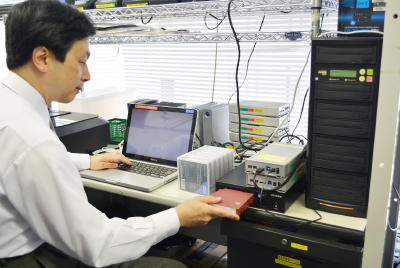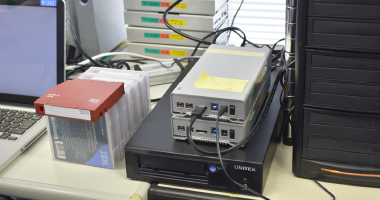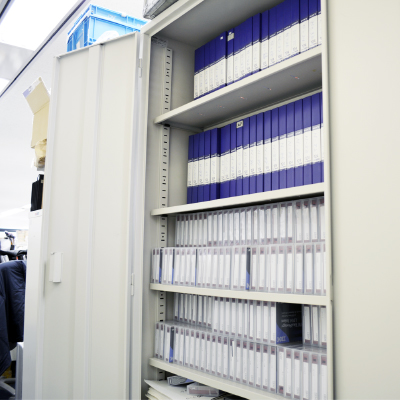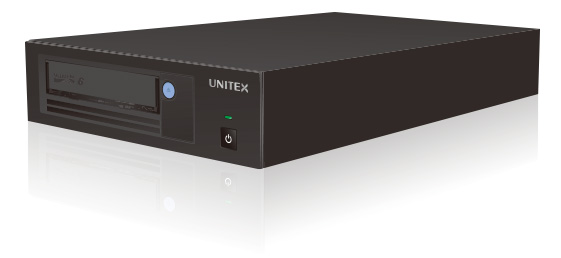


In the video production industry which traditionally uses video tape at shooting even digitization of television has been getting popular, still there are many companies who have hard time to consider how to store the tapes for TV material. Nikkei Visual Images, Inc., who is making information program and documentary program such as "Dawn of GAIA" & "Kirin Art Gallery", is one of the companies who are facing a problem continuously that many video tapes were overflowed to the office. As a countermeasure of the problem, they re-examined internal archive system and paid attention to the LTO tape which can store large capacity of the data long-term period. By the functions of "easy connection to PC with USB3.0", "easy operation of Drag & Drop to make a copy from HDD to LTO tape", and "inexpensive system", they determined to use "LT50 USB" as a solution to archive many numbers of video tapes.
Mr. Katsuki Honda
ProducerTV program Dept.
NIKKEI VISUAL IMAGES, INC.

"Although 4K and 8K high resolution cameras are introduced recently, the majority of the coverage and the location of the TV program are still recorded to video tape" Mr. Katsuki Honda said.
For instance, if we will make 30 minutes of full-length interview program, 10 to 20 pcs of HD cam video tapes will be necessary. If we will make 60 minutes of documentary program, almost 100 pcs of HDV 60 minutes tapes will be necessary. The most of the cases, those of the material tapes are stored immediately. It is rare that the tapes are discarded after broadcasting or will be used in next shooting after erase of the contents. Because, in the regular program, the past interview tape is required very often. Also, even in one-shot special program, past material is required when a sequel to the program will be made. In addition, there are many cases that landscape and nature of domestic and overseas cities will be required in other programs. There are feelings that the program officer who took the videoshooting with big difficulties does not want to erase the tape easily. Therefore, NIKKEI VISUAL IMAGES has been doing to dispose the tapes which have been determined to not need to be stored by industrial waste service twice in a year. However, there are many tapes which cannot be discarded forever. Space to store the video was not enough in basement of the company and the tapes were piled up on the rockers in the office. So, when it began to consider how to archive internal video data efficiency, LTO tape was singled out.

Good point is that everyone can easily operate without asking to help to the operators
“Since 2000, main device for video edit has been rapidly shifted from tapes to data by advances of computer technology. TV program Dept. adopted the system using ProRes format which can compress high vision video signal with almost no deterioration. The work process is that the image of the video tape was created data into ProRes format using a dedicated compression device, and saved to an external HDD which has about 3TB capacity. By using the "digitized" data, the program director made nonlinear editing by PC, and the data is written to the video tape for broadcast in post production. Then after processing a telop, the TV program is completed.”
From 2010 when such a workflow is established, the HDD used in editing is stored as it is rather than video tape. If we do this way, to save the interview tape will become not necessary. Compared to the video tape, the cost to store the data can be reduced to about one-tenth, the space can be reduced to about one-thirtieth. However, there was very critical issue on the HDD solution.
“Since the hard disk is an electrical product, there is a possibility of failure. In addition, the hard disk manufacturers do not publish the life-time of the disk. So, we could not feel at ease when we considered about long-term storage of the important video data by HDD. Because of these reasons, re-use and disposal of the video tape did not proceed well. Later, as a result of various studies, we concluded to store the video data to the LTO tape which has similar capacity of HDD, has compact size than HDD and is published as 30 years life-time.”
NIKKEI VISUAL IMAGES configured the LTO tape archive system with LT50 USB and MacBook Pro 13" by USB3.0 connection. One of the advantages of the LTO system at the selection is that the system has accomplished easy operation. The operator only needs "Drag & Drop" of the data in the HDD and move to LTO folder in MacBook Pro.

“Even we compared systems of each manufacturers when we started to consider to implement archive to LTO tape, we found the most of the systems are composed of LTO drive, dedicated PC and archive software, and the prices are very expensive. In addition, since the systems require to digitize the video data from video tape, both time and resource will be required. During the investigation, we found "LT50 USB" which does not need to digitize the video data. This can store the digitized video data for nonlinear editing to LTO tape without change of the format, and can save various different type of formatted videodata such as film scripts, still image CG and etc. Under current situation which we could not spend big amount of resource and money, we think we have accomplished to make an unprecedented simple system from perspective of efficiently how video data can be stored.”
When we started to use LT50 USB and started to archive by LTO tape, the cost and the necessary storage space became half in compared with the space for the archiving to the HDD. Video tapes need a space such as medium size of a cardboard box. The space became a LTO tape which can be put on the palm. As a result, we were released from the situation that the video material has been overflowing to the office. In the past, we hesitated many times whether the data should be saved or not, since we considered if the data has a possibility to be used in the future even we basically have to dispose the data because of the limitation of storage space. However, currently we can save the data for the time being when we hesitate to save or not. It is good advantage from our mental health standpoint because we can judge later if the data is unnecessary and can be erased or the data can be re-used. The LTO video archive system is a kind of savior for the video production companies who have been having problems to archive the huge video material.

Although many cardboards which contained video tapes were piled up everywhere, currently we can organize the compact LTO tape in the rack.

* The listed company name and product names are registered trademarks or trademarks of their respective owners. The contents are as of March 2015.
Please note that the information contained in this catalog is information at the time of interview and it may have been changed when it is viewed. time it is viewed.